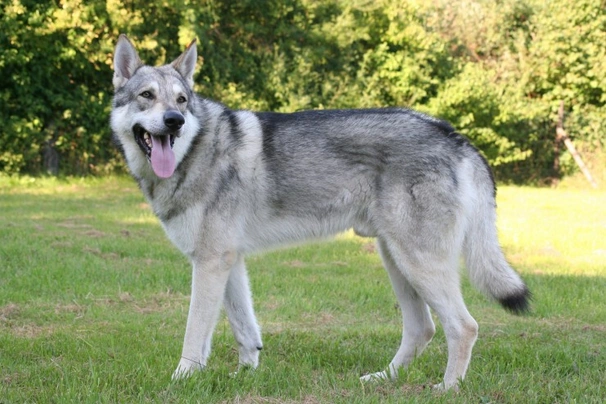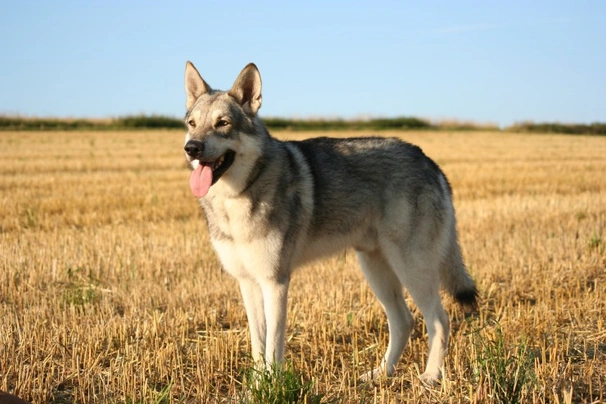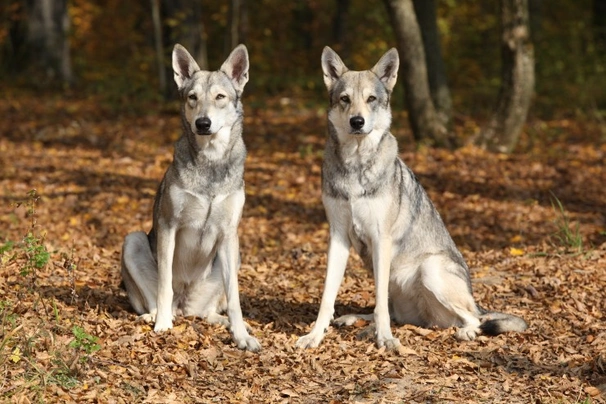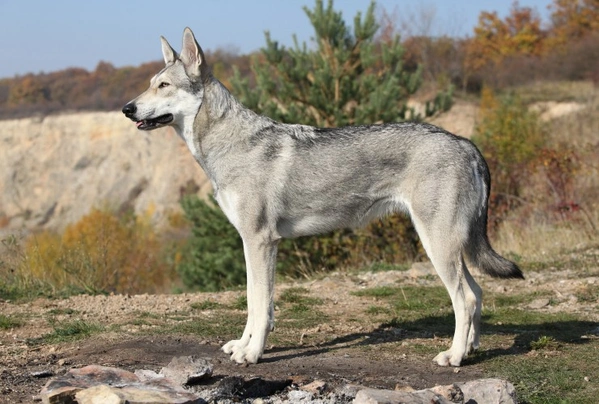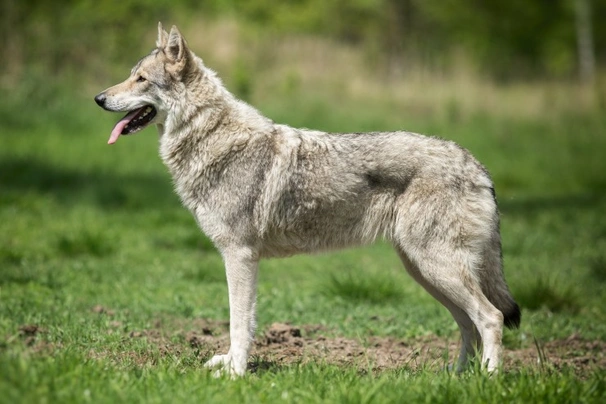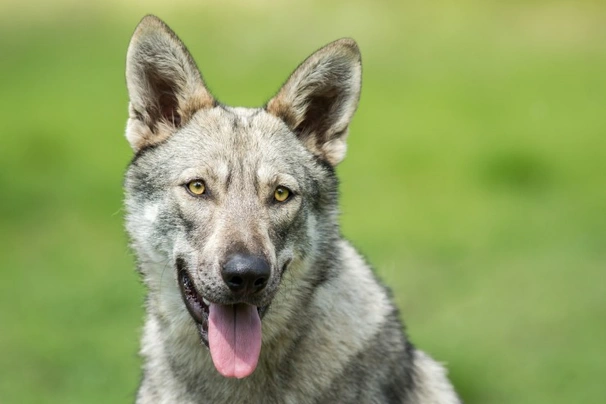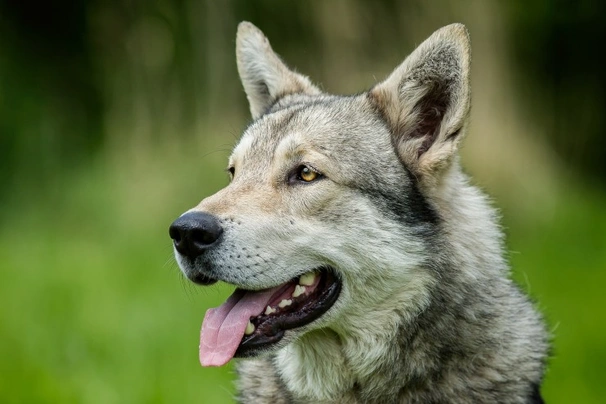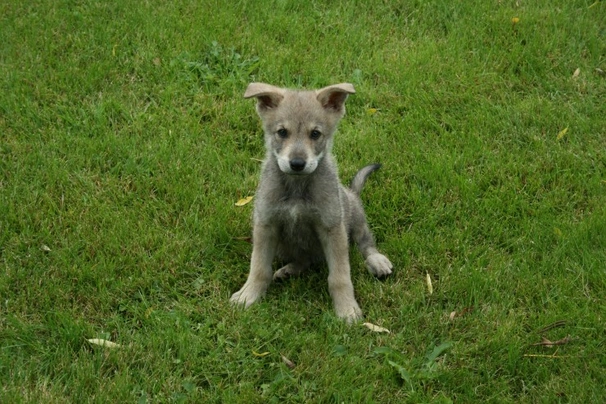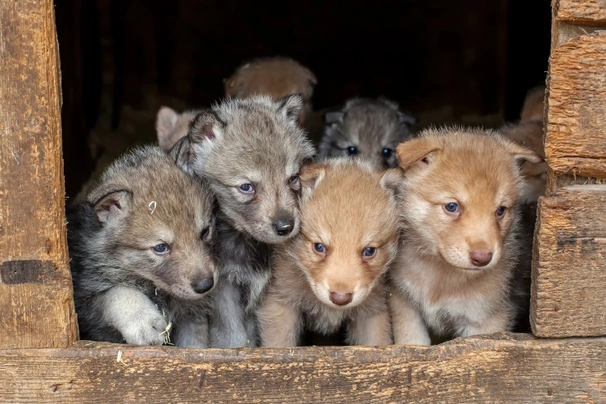Saarloos Wolfdog
Pros
Cons
Introduction of the Saarloos Wolfdog
The Saarloos Wolfdog is a strikingly wolf-like breed, immediately catching the eye with its distinctive features that echo its wild ancestry. Originally bred in the 1930s by crossing the German Shepherd with a European Wolf, this breed was designed to embody more natural behaviours than traditional working dogs. Though relatively rare in the UK, the breed enjoys a dedicated following internationally due to its loyal, kind nature and its majestic, wolf-like appearance.
Primarily a companion dog today, the Saarloos Wolfdog carries an athletic build and a reserved temperament, often displaying caution around strangers while forming strong, intimate bonds with their families. They thrive in homes where active owners can provide consistent training, mental stimulation, and ample exercise. Notably, the breed demands experienced handling, given their natural independence and high prey drive, making them less suited to first-time dog owners.
This breed requires commitment to daily exercise, at least 40-60 minutes with opportunities for off-lead time, coupled with plenty of mental engagement to prevent boredom and destructive behaviours. Their grooming needs are moderate, benefiting from regular brushing especially during seasonal coat changes. Owners must also be prepared for the challenges of finding a well-bred puppy, as few are bred annually in the UK, leading to waiting lists and careful selection.
Perfect For
Active individuals or families experienced with intelligent, independent breeds who can provide firm leadership and appreciate the Saarloos Wolfdog's unique wolf-like appearance and behaviour. Homes with secure gardens and those who enjoy outdoor sports and activities suited to energetic medium-large dogs will find a perfect companion in the Saarloos.
Key Considerations
Potential owners must be aware of the breed’s natural wariness of strangers and high prey drive, requiring robust socialisation and consistent training from an early age. Due to their size and exercise needs, they are not suitable for small flats or sedentary lifestyles. They also need experienced handling to prevent dominant behaviour and to manage potential separation anxiety. Finally, the scarcity of quality breeders in the UK means patience and diligence are essential when acquiring a puppy.
History of the Saarloos Wolfdog
The Saarloos Wolfdog was conceived in the 1930s in the Netherlands by Leendert Saarloos, a Dutch breeder keen to enhance the working potential of the German Shepherd through crossing it with a European Wolf from the Rotterdam Zoo. His aim was to produce a dog manifesting more natural, less aggressive instincts, creating a calm yet capable working breed. Although the resulting dogs were more reserved and less confrontational than expected, they possessed a distinct, wolf-like appearance and temperament.
Early Development
Leendert Saarloos carefully managed the breeding programme until his death in 1969, emphasising health and temperament traits aligned with his vision. The breed was formally named in his honour in 1975 when the Dutch Kennel Club recognised it. Early breeding focused heavily on maintaining genetic health and avoiding exaggerated traits, aiming to balance the dog's wolfish influence with the trainability of the German Shepherd.
Modern Recognition
The Saarloos Wolfdog saw international recognition with the Fédération Cynologique Internationale (FCI) in 1981 and the United Kennel Club of America in 2006. Despite these milestones, the breed remains unrecognised by The Kennel Club in the UK as of 2025. Breed enthusiasts continue to uphold rigorous breeding standards through local clubs, promoting health testing and responsible breeding to ensure the breed's future. While historically some Saarloos were trained as assistance dogs, most are cherished as loyal family companions today.
Appearance of the Saarloos Wolfdog
Size and Build
The Saarloos Wolfdog is a large, athletic dog with males typically standing between 65 and 75 cm at the withers and females between 60 and 70 cm. Both genders weigh in the range of 36-41 kg, presenting a balanced, medium-long body slightly longer than tall. The breed exhibits well-defined musculature, broad flat skulls, and wedge-shaped heads contributing to their unmistakably wolf-like profile.Coat and Colours
Their dense double coat features a coarse, weather-resistant outer layer with a soft, insulating undercoat. This coat thickens in winter, often forming a ruff around the neck, and thins during summer months. Accepted colours include wolf grey, red, and white, each accentuating the wild look. Seasonal shedding occurs primarily during spring and autumn when more frequent grooming is needed to manage loose hair.Distinctive Features
The breed’s head has a slight stop with a muzzle as long as the skull and a straight nasal bridge. Almond-shaped eyes set obliquely often show a captivating yellow hue, although brown eyes are also seen. Their medium-sized ears are triangular with rounded tips, positioned at eye level, and their tail is carried low in a sabre shape, heavily plumed with fur. Movement is fluid and purposeful, reflecting their natural stealth and endurance.Gender Differences
Males tend to be larger and slightly heavier, with more pronounced muscle mass and presence. Temperamentally, males may show stronger dominance traits, whereas females often display a more reserved demeanour. Both require active lifestyles and benefit from consistent training to direct their intelligence and energy positively.Temperament of the Saarloos Wolfdog
Core Personality Traits
Saarloos Wolfdogs are naturally reserved, cautious, and non-confrontational, often choosing avoidance over aggression when faced with strangers. They are loyal and form strong bonds with their families, displaying intelligence and independence. This combination creates an energetic and high-maintenance companion that thrives on understanding and structured guidance.Social Behaviour
They tend to be wary of unfamiliar people and often show a strong desire to withdraw rather than react aggressively. While usually gentle with known individuals, their high prey drive renders them unsuitable to coexist safely with small animals unless raised together from an early age. With other dogs, they often prefer to live with at least one companion, thereby satisfying their instinctual pack needs.Working Instincts
Although originally bred with guard dog intentions, the Saarloos Wolfdog's temperament is more aligned with a watchful companion than an aggressive protector. Their alertness and intelligence make them suitable for canine sports like agility and obedience, and they excel in activities requiring endurance and focus.Common Behavioural Challenges
Potential owners should be mindful of their strong pack instincts which, if not managed properly, can lead to dominant or challenging behaviour. Early, consistent socialisation is crucial to preventing behavioural issues, along with dedicated training to channel their high energy and intelligence. Separation anxiety is common without sufficient companionship and mental stimulation, and owners should provide a secure environment to prevent escape attempts due to their roaming tendencies.Intelligence / Trainability of the Saarloos Wolfdog
The Saarloos Wolfdog displays keen intelligence and fast learning ability, though their independent streak can pose challenges. Early and consistent training combined with socialisation is essential to mould this wolf-like dog into a well-behaved member of the family. They respond best to positive reinforcement methods and fair, firm leadership, requiring training sessions to be engaging and relatively short to maintain focus.
Puppy Training Priorities
Focusing on socialisation is critical in the first six months, exposing puppies cautiously to new people, animals, and environments. Basic commands like sit, stay, come, heel, and leave it should be introduced early with gentle patience, as toilet training can take up to 10 months. Establishing boundaries and leadership early helps prevent dominance issues later in life.
Training Methods That Work
Due to their sensitivity, Saarloos do not respond well to harsh correction or punitive methods. Using treats, praise, and play as rewards fosters motivation. Short, frequent sessions of 10-15 minutes, multiple times per day, maintain interest and reduce boredom. Variety in training aids concentration and improves obedience.
Advanced Training Potential
The breed excels in canine sports such as obedience, agility, tracking and even search and rescue work, benefiting from their stamina and intelligence. Consistent mental challenges and physical exercise are crucial to keep a Saarloos healthy and happy.
Common Training Mistakes
Owners often spoil Saarloos puppies due to their charm, inadvertently encouraging bad habits. Neglecting socialisation or leadership can lead to dominant behaviour or fearfulness. Overexertion during puppyhood risks joint damage and health issues later, so care must be taken until maturity.
Children and other
Age-Specific Interactions
Saarloos Wolfdogs bond well with children they are raised alongside, particularly older children who understand how to respect this sensitive breed. They may be wary or reserved around unfamiliar children, making supervision and gradual introductions key. Toddlers should always be closely monitored to ensure gentle interactions.Teaching Children Proper Interaction
Children should be taught boundaries with the Saarloos, including not disturbing the dog while resting and avoiding rough play. Respecting the dog’s space helps prevent stress-related reactions. Educating children on reading canine body language enhances safety and mutual trust.
Breed-Specific Considerations
Given the Saarloos Wolfdog's size and sensitivity, families need to manage energetic play and avoid overwhelming the dog. Their high prey drive means smaller pets should be kept separate. Their reserved nature means patience from children, especially during socialisation periods, is essential.
Creating Safe Environments
Supervised interaction areas and secure, fenced gardens provide safe spaces for the breed and children. Consistent routines and positive reinforcement build a harmonious family setting, ensuring the dog’s needs are met without compromising children’s safety.
Health of the Saarloos Wolfdog
Breed-Specific Health Conditions
Saarloos Wolfdogs have a moderate lifespan of 12 to 14 years but are prone to certain hereditary health problems including hip and elbow dysplasia, pituitary dwarfism, degenerative myelopathy, progressive retinal atrophy, hereditary cataracts, glaucoma, and spondylosis of the spine. These conditions require regular veterinary monitoring and responsible breeding to minimise risk.Genetic Testing Requirements
Responsible breeders use health screening such as BVA hip and elbow scoring, DNA testing for degenerative myelopathy and pituitary dwarfism, and eye testing for progressive retinal atrophy, cataracts and glaucoma to ensure breeding stock is free of inherited issues. Carriers or affected dogs are excluded from breeding programmes.Preventive Healthcare Schedule
Puppies receive initial vaccinations before sale, with follow-up vaccines at 10-12 weeks and boosters scheduled as advised by vets. Parasite control, dental care and annual health checks are essential to maintain overall health through life stages.Insurance Considerations
Given the breed’s predisposition to hereditary conditions and size, insurance premiums may be higher than average. Lifetime policies can provide financial security against costly treatments. Owners should discuss breed-specific concerns with insurers to find appropriate coverage.Caring for the Saarloos Wolfdog
Regular grooming twice weekly keeps the Saarloos Wolfdog's thick double coat healthy and reduces shedding, with increased brushing in spring and autumn during seasonal molts. Their skin and ears should be checked routinely to prevent infections, and nail trimming is necessary to maintain comfort and mobility.
Daily Care Routine
Daily exercise is vital—typically 40 to 60 minutes of walking supplemented by off-lead play and mental stimulation. Feeding should be consistent with age-appropriate high-quality diets, and fresh water must always be available. Owners should monitor for signs of stress or behavioural changes indicative of health concerns.
Living Environment Needs
This breed thrives in homes with secure, high fencing and gardens allowing freedom to roam safely. They require enough space to explore and expend energy, making them unsuitable for small flats. Climate considerations include protection from excessive heat due to their dense coats.
Seasonal Care Adjustments
In summer, ensure access to shade and water to prevent overheating. During winter, their thick coat offers protection, but older dogs may need extra warmth. Seasonal shedding necessitates grooming adjustments to maintain coat and skin health.
Senior Care Adaptations
As they age, Saarloos may develop arthritis or reduced stamina, requiring gentle exercise and softer bedding. Dietary adjustments with lower fat and higher digestibility support health. Regular vet visits become more frequent to monitor evolving needs.
Grooming of the Saarloos Wolfdog
Coat Maintenance Schedule
The Saarloos Wolfdog's double coat requires brushing at least twice weekly, with more frequent sessions during heavy shedding periods in spring and autumn to remove loose undercoat and prevent matting. A typical brushing session lasts around 15-20 minutes.Professional Grooming Requirements
Although the breed is relatively low maintenance, occasional professional grooming every 3-4 months can help maintain coat condition and skin health, especially for older dogs or those with heavier coats.Home Grooming Techniques
Use slicker brushes and grooming gloves to effectively remove dead hair while being gentle on the skin. Regular ear checks and cleaning prevent infections. Nail clipping, ideally every 3-4 weeks, avoids overgrowth and discomfort. Teeth should be brushed frequently to prevent tartar buildup.Common Grooming Challenges
Managing the seasonal shedding requires diligence to prevent mats and maintain a clean home. Ear wax buildup can lead to infections if unchecked. Allergies might cause skin irritation necessitating vet consultation for appropriate treatments.Exercise of the Saarloos Wolfdog
Daily Exercise Requirements
Saarloos Wolfdogs need at least 40 to 60 minutes of dedicated physical exercise daily, complemented with off-lead time in secure areas to satisfy their natural roaming instincts. Their high energy and intelligence mean they require both physical and mental stimulation to remain balanced.Suitable Activities
Activities such as long walks, jogs, canine sports like agility, flyball, obedience, tracking, and search and rescue exercises suit the breed well and help prevent boredom. Playful interactions and training games provide mental engagement.Exercise Restrictions
Puppies need limited exercise avoiding high impact activities or stairs to protect developing joints. Older dogs require gentler exercise adjusted for stamina and health. Extreme weather conditions call for exercise adjustments to prevent heat stroke or hypothermia.Mental Stimulation Ideas
Puzzle toys, scent work, training drills, and interactive play aid mental fitness. Frequent changes in routine and environments also enrich their experiences and keep their minds sharp.Feeding of the Saarloos Wolfdog
Nutritional Requirements
Saarloos Wolfdogs need a balanced diet rich in high-quality proteins (around 20-25%), moderate fat content, and controlled carbohydrates to maintain their active lifestyle and lean muscle mass. Caloric needs vary with age, weight, and activity level, requiring adjustments over the dog's life.Feeding Schedule Guidelines
Puppies should be fed 3-4 times daily with portion sizes gradually adjusted from about 286g at 2 months to adult quantities by 15 months. Adult dogs are typically fed twice daily with portions ranging from approximately 350g to 500g depending on body weight and energy expenditure.Special Dietary Considerations
Due to potential sensitivities, avoid foods with excessive fillers like cereals and artificial additives. Supplements such as omega-3 fatty acids may support coat and joint health. Monitor for any allergic reactions and consult vets when dietary changes are needed.Weight Management
Maintaining ideal body condition is vital to prevent obesity, which can cause severe health issues including joint strain and heart problems. Regular weight checks and consistent exercise complement dietary control to keep Saarloos fit and healthy.Saarloos Wolfdog price
Due to the Saarloos Wolfdog's rarity in the UK, potential owners must register interest with breeders and may be placed on waiting lists. Typically, well-bred pedigree Saarloos puppies start from around a800 to a31,500 depending on breeder reputation and lineage quality, although initial reports indicated prices from a3400 upward previously. The breed commands a premium due to the careful breeding and genetic health testing involved.
Initial setup costs include quality crates, beds, grooming tools, and training supplies, usually costing between a3200 to a3500. Monthly expenses for food, grooming, and routine vet care average a360 to a390, factoring in quality diet and insurance policies. Annual vet costs with vaccinations, boosters, and health checks can push yearly expenses beyond a3900.
Insurance premiums vary geographically and with coverage, with basic insurance averaging around a321.50 monthly for a young adult and lifetime cover approximately a347.75 per month. Prospective owners should budget for ongoing health scrutiny and potential hereditary health expenses. For those interested, you can find Saarloos Wolfdog for sale on Pets4Homes.
Buying advice
Purchasing a Saarloos Wolfdog requires considerable care to ensure you acquire a healthy, well-bred puppy suited to your lifestyle. Due to their rarity and the breed's specific needs, it's imperative to deal with reputable breeders. You can find Saarloos Wolfdog for sale via Pets4Homes to start your search.
Finding Ethical Breeders
Look for breeders who prioritize health testing and socialization, ask to see the puppy's parents, and the breeding environment. A responsible breeder will welcome questions about lineage, health clearances, and breeding practices, adhering to limits on dam litters and age.
Health Testing Verification
Ensure breeders provide documentation for BVA hip and elbow scores, genetic tests for degenerative myelopathy and pituitary dwarfism, and eye examinations for hereditary conditions. Avoid breeders unwilling or unable to provide full health records.
Puppy Selection Process
Assess a puppy's temperament for confidence and sociability during visits. Check physical health signs such as clear eyes, healthy coats, and proper weight. Avoid puppies exhibiting fearfulness or dominant behaviours without proper training history.
Contract and Guarantee Review
Review all sale contracts for health guarantees and return policies. Be wary of unusually low prices or sellers unwilling to provide comprehensive paperwork, which may signal irresponsible breeding or scams.
Rescue and Adoption Options
Consider adopting from breed-specific rescues, which occasionally have Saarloos Wolfdogs available. Adoption provides a loving home to dogs in need and supports welfare efforts within this rare breed.
